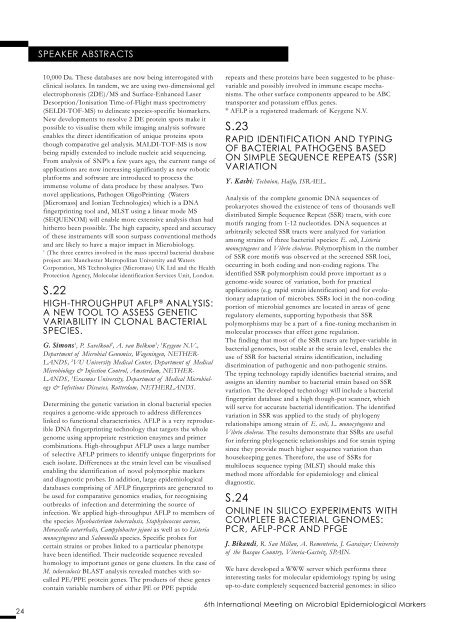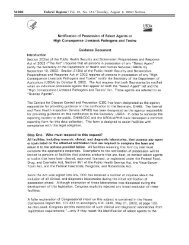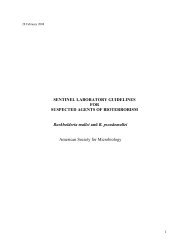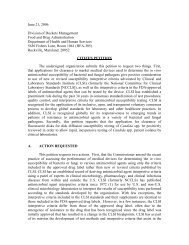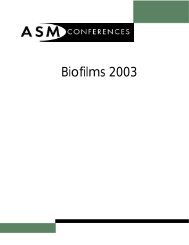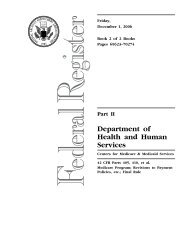Program and Abstract Book - Microbiology
Program and Abstract Book - Microbiology
Program and Abstract Book - Microbiology
You also want an ePaper? Increase the reach of your titles
YUMPU automatically turns print PDFs into web optimized ePapers that Google loves.
SPEAKER ABSTRACTS10,000 Da. These databases are now being interrogated withclinical isolates. In t<strong>and</strong>em, we are using two-dimensional gelelectrophoresis (2DE)/MS <strong>and</strong> Surface-Enhanced LaserDesorption/Ionisation Time-of-Flight mass spectrometry(SELDI-TOF-MS) to delineate species-specific biomarkers.New developments to resolve 2 DE protein spots make itpossible to visualise them while imaging analysis softwareenables the direct identification of unique proteins spotsthough comparative gel analysis. MALDI-TOF-MS is nowbeing rapidly extended to include nucleic acid sequencing.From analysis of SNP’s a few years ago, the current range ofapplications are now increasing significantly as new roboticplatforms <strong>and</strong> software are introduced to process theimmense volume of data produce by these analyses. Twonovel applications, Pathogen OligoPrinting (Waters[Micromass] <strong>and</strong> Ionian Technologies) which is a DNAfingerprinting tool <strong>and</strong>, MLST using a linear mode MS(SEQUENOM) will enable more extensive analysis than hadhitherto been possible. The high capacity, speed <strong>and</strong> accuracyof these instruments will soon surpass conventional methods<strong>and</strong> are likely to have a major impact in <strong>Microbiology</strong>.1(The three centres involved in the mass spectral bacterial databaseproject are: Manchester Metropolitan University <strong>and</strong> WatersCorporation, MS Technologies (Micromass) UK Ltd <strong>and</strong> the HealthProtection Agency, Molecular identification Services Unit, London.S.22HIGH-THROUGHPUT AFLP ® ANALYSIS:A NEW TOOL TO ASSESS GENETICVARIABILITY IN CLONAL BACTERIALSPECIES.G. Simons 1 , P. Savelkoul 2 , A. van Belkum 3 ; 1 Keygene N.V.,Department of Microbial Genomics, Wageningen, NETHER-LANDS, 2 VU University Medical Center, Department of Medical<strong>Microbiology</strong> & Infection Control, Amsterdam, NETHER-LANDS, 3 Erasmus University, Department of Medical <strong>Microbiology</strong>& Infectious Diseases, Rotterdam, NETHERLANDS.Determining the genetic variation in clonal bacterial speciesrequires a genome-wide approach to address differenceslinked to functional characteristics. AFLP is a very reproducibleDNA fingerprinting technology that targets the wholegenome using appropriate restriction enzymes <strong>and</strong> primercombinations. High-throughput AFLP uses a large numberof selective AFLP primers to identify unique fingerprints foreach isolate. Differences at the strain level can be visualisedenabling the identification of novel polymorphic markers<strong>and</strong> diagnostic probes. In addition, large epidemiologicaldatabases comprising of AFLP fingerprints are generated tobe used for comparative genomics studies, for recognisingoutbreaks of infection <strong>and</strong> determining the source ofinfection. We applied high-throughput AFLP to members ofthe species Mycobacterium tuberculosis, Staphylococcus aureus,Moraxella catarrhalis, Campylobacter jejuni as well as to Listeriamonocytogenes <strong>and</strong> Salmonella species. Specific probes forcertain strains or probes linked to a particular phenotypehave been identified. Their nucleotide sequence revealedhomology to important genes or gene clusters. In the case ofM. tuberculosis BLAST analysis revealed matches with socalledPE/PPE protein genes. The products of these genescontain variable numbers of either PE or PPE peptiderepeats <strong>and</strong> these proteins have been suggested to be phasevariable<strong>and</strong> possibly involved in immune escape mechanisms.The other surface components appeared to be ABCtransporter <strong>and</strong> potassium efflux genes.®AFLP is a registered trademark of Keygene N.V.S.23RAPID IDENTIFICATION AND TYPINGOF BACTERIAL PATHOGENS BASEDON SIMPLE SEQUENCE REPEATS (SSR)VARIATIONY. Kashi; Technion, Haifa, ISRAEL.Analysis of the complete genomic DNA sequences ofprokaryotes showed the existence of tens of thous<strong>and</strong>s welldistributed Simple Sequence Repeat (SSR) tracts, with coremotifs ranging from 1-12 nucleotides. DNA sequences atarbitrarily selected SSR tracts were analyzed for variationamong strains of three bacterial species: E. coli, Listeriamonocytogenes <strong>and</strong> Vibrio cholerae. Polymorphism in the numberof SSR core motifs was observed at the screened SSR loci,occurring in both coding <strong>and</strong> non-coding regions. Theidentified SSR polymorphism could prove important as agenome-wide source of variation, both for practicalapplications (e.g. rapid strain identification) <strong>and</strong> for evolutionaryadaptation of microbes. SSRs loci in the non-codingportion of microbial genomes are located in areas of generegulatory elements, supporting hypothesis that SSRpolymorphisms may be a part of a fine-tuning mechanism inmolecular processes that effect gene regulation.The finding that most of the SSR tracts are hyper-variable inbacterial genomes, but stable at the strain level, enables theuse of SSR for bacterial strains identification, includingdiscrimination of pathogenic <strong>and</strong> non-pathogenic strains.The typing technology rapidly identifies bacterial strains, <strong>and</strong>assigns an identity number to bacterial strain based on SSRvariation. The developed technology will include a bacterialfingerprint database <strong>and</strong> a high though-put scanner, whichwill serve for accurate bacterial identification. The identifiedvariation in SSR was applied to the study of phylogenyrelationships among strain of E. coli, L. monocytogenes <strong>and</strong>Vibrio cholerae. The results demonstrate that SSRs are usefulfor inferring phylogenetic relationships <strong>and</strong> for strain typingsince they provide much higher sequence variation thanhousekeeping genes. Therefore, the use of SSRs formultilocus sequence typing (MLST) should make thismethod more affordable for epidemiology <strong>and</strong> clinicaldiagnostic.S.24ONLINE IN SILICO EXPERIMENTS WITHCOMPLETE BACTERIAL GENOMES:PCR, AFLP-PCR AND PFGEJ. Bik<strong>and</strong>i, R. San Millan, A. Rementeria, J. Garaizar; Universityof the Basque Country, Vitoria-Gasteiz, SPAIN.We have developed a WWW server which performs threeinteresting tasks for molecular epidemiology typing by usingup-to-date completely sequenced bacterial genomes: in silico246th International Meeting on Microbial Epidemiological Markers


